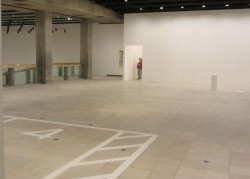The exhibition Invisible – Art about the Unseen, at the Hayward Gallery in London’s Southbank Centre, brings together pieces from 1957-2012 to show that the immaterial is the main ingredient for art. The exhibition, in display until August 5th, includes works by some of the most important artists of our time, like Yves Klein, to whom the start of invisible art can be attributed to. In 1957 he opened an exhibition that included a seemingly empty room. According to the artist, however, the white walls of that space were infused with the presence of ‘pictorial sensibility in the raw state’. Just the fact of being in an art gallery is already a factor to feel the presence of art, even in its absence.
Art is determined by a frame of mind. That is proven by Terry Atkinson and Michael Baldwin’s piece “The Air-Conditioning Show” (1972) where an empty room is occupied only by air-conditioners that ‘acclimatize’ the ambient, creating an artistic atmosphere with the support of texts about the piece. The rhetoric that creates the frame surrounding art is noticed through the conventions used to describe and display them. Following this path, the Italian artist Bruno Jackob, who has been making invisible paintings for more than 30 years, relied on the titles of his blank canvas pieces to create a frame by which the visitor would experience his art. Many visitors did not know how to behave in the exhibition, they seemed unsettled by the blank canvases and an old lady did not enter the air-conditioning room because she did not know it was part of the exhibition.
Just the effect on our behaviour and imagination around the show is already the effect intended. This was physically felt in Teresa Margolles “Air” (2003) where she fills a room with vapour produced with water from public mortuaries in Mexico City. As a true conceptual art it had a political statement behind the dematerialized piece. Language is a very strong medium by which a work of art can occur on our imagination. Yoko Ono explored this field with her “Hand Piece”: Raise your hand in the evening light and watch it until it becomes transparent and you see the sky and the trees through it. (Summer, 1967) Like poetry, words materialize in our head. It made me think of all the things that affects us but we can’t see, like the presence of a deceased person we cared for.
In James Lee Byars’s “The Ghost of James Lee Byars” (1969) this kind of presence of absence force is created in a room where everything is pitch dark, by going alone one can feel frightened by the possibility of encountering a ghost. Chris Burden uses the same principle in his work “White Light/ White Heat” (1975) where he hid on the gallery and visitors would be affected by the idea that there was someone watching them but they could not see, like God, the power of presence in the absence.
Andy Warhol also explored the idea of invisibility by creating pornographic paintings using fluorescent ink, so it could only be seen with the lights off. In case any authorities came to censor the exhibition he would turn the lights on. For his “Invisible Sculpture” (1985) he would stand aside an empty pedestal for a moment and then leave, while the piece maintained its significance by the atmosphere he created with his presence, which was so powerful that it still affects us even after his death.
Overall the exhibition was very interesting with sprinkles of humour. Carsten Höller brings an invisible car to the show that reminds us of “The Amazing Race” cartoon. Maurizio Cattelan presents an official police report registering the theft of an invisible artwork. Jeppe Hein closes the show with his “Invisible Labyrinth” (2005), where people could go around virtual mazes guided by a device that vibrated whenever you touched an invisible wall.
All these works made me feel the need to look at the unnoticed. Also, it brought to my mind the awareness that there are many things that we don’t look at but are happening all around us. People are guided by beliefs, curses affect without being seen, there are many examples. So, if the intention makes the work of art, it also makes life. Then, we should change our intentions to affect our life in a good way.



